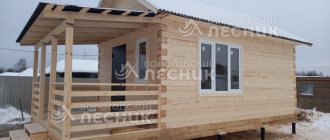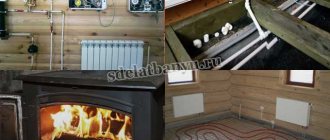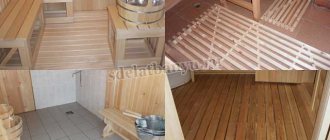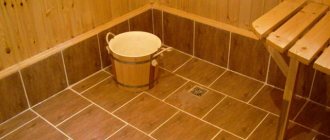Many people face the problem of water supply in winter baths without constant heating. And everyone is looking for a solution that would be optimal specifically for their case. We think this is right. However, in order to choose the best option, you need to have an idea of all available at your disposal. This article will be an overview of all effective options.
Simple winter water supply to the bathhouse
Sometimes a water supply is laid from the source to the bathhouse by air. To use it in winter, the pipes are well insulated, but this does not guarantee that they will not freeze. A method is used when the highway is laid with a large slope in any direction. Hoses are not used for this - they sag, there is always a place where a little liquid remains. Pipes are used that are connected to the pump at one end and lowered into a storage tank at the other.
When the pump is turned on, it pumps water into the tank. When it is turned off, the liquid flows by gravity into the well or reservoir, leaving nothing in the pipes. No shut-off valves are installed on the pipeline. Pumping equipment must ensure water drainage if the slope is in its direction. Vibration models have these properties. For others, a drain valve is installed on the supply pipe. If water is drawn from a well, it is insulated and a caisson is installed at the well.
Organization of winter water supply
Organizing a winter water supply for a bathhouse complex will require solving a number of issues:
- choice of water supply scheme: with drainage of water after each use or a heated room.
- choice of heating source: central or local;
- choosing a water source: water supply, borehole or well;
- selection of pipe material;
Before making a choice, you should carefully calculate how much a particular solution will cost when implemented. This will include the cost of materials, equipment and labor.
Separately, you need to calculate the amount of operating costs over the planned life of the system. This amount includes:
- heating costs (gas, electricity, solid or liquid fuel);
- cost of preventive maintenance (periodic cleaning of the well, blowing out the well, maintenance of heating equipment, etc.)
- cost of spare parts, repairs and consumables if required).
The sum of these three types of costs will represent the total cost of ownership of a particular system. For example, an insufficiently insulated pipe will require large amounts of electricity to constantly heat it. And the use of metal-plastic pipes will require their replacement every few years due to corrosion of metal parts and chipping of rubber gaskets.
Laying pipes in dry soil
If pipes are laid underground, take into account the level of soil water. If they are far away, installing an underground water supply to the bathhouse is not difficult. The pipes are made of polyethylene; other plastic or steel are not suitable. They dig a trench at least 0.5 m deep. Even if the polyethylene pipe freezes, it is so elastic that it will remain intact. To reliably protect against frost, they are buried 20-30 cm below the soil freezing level and insulated.
Laying the pipe in a trench under the bathhouse.
The weak point of the water supply system is the metal taps and fittings used to connect individual branches of the system. Polyethylene pipes can be joined with couplings if water drains from the pipes. In an unheated room, steel couplings and bends are discarded. They are connected end-to-end using a soldering iron, creating a continuous line. Classic taps are made of cast iron or other metal - they are not as sensitive to frost as ball taps.
Defrosting accessible pipe sections
You can deal with ice jams on open sections of communications, usually located in a building, using the following means:
- Hairdryer, construction or household, vacuum cleaner with the ability to connect a hose to the outlet, fan heater. Using the device, a stream of warm air first warms up the area near the tap, then it is necessary to gradually move along the entire pipe. When handling plastic communications, care must be taken to prevent them from melting.
- Boiling water, which, in the absence of electricity, is heated over a fire. The supposedly frozen section of pipe is wrapped in any rags, rags, old towels, then watered with a thin stream of hot water to keep the fabric moist and warm. The procedure continues until the ice completely melts.
- Electric heating consists of wrapping the communication with a heating wire connected to the network. The duration of defrosting depends on the length of the ice plug and can last up to 3 hours.
Advice! A serious mash can only be heated using a blowtorch in a thick-walled metal pipe. But to prevent damage to communications, this method must be used extremely carefully.
Winter water pipe with valve
In regions with frosts greater than -20°C, a valve drain is installed on the water supply in a bathhouse without heating. This is done like this:
- A well is dug under the main pipe using a garden drill. Its depth is 0.5 m greater than the freezing level.
- An elbow made of the same plastic in the shape of the letter U is soldered into the pipe above the well. A hole is drilled at its lowest point and a fitting is inserted.
- A sand cushion is placed at the bottom of the well. A hose is put on the fitting, its other end is covered with a geotextile cover. It should rest against the sand at the bottom of the well.
When people wash in a bathhouse, part of the water entering under pressure goes through this valve into the soil. There is not much of it: if you use the sauna all day - 1-2 buckets. When the inlet valve is closed, the water goes through the drain elbow into the ground. Even if a mini-well is installed outside and the water begins to freeze, the pipes will not burst. As the liquid expands, it pushes excess moisture into the soil.
Valve drainage of water from the bath.
The only thing that needs to be taken into account is the depth of the water layer. If it is close to the surface, this option is not used - the underground aquifers will be polluted.
Methods for defrosting hidden underground and other inaccessible sections of pipes
Using hot water to remove ice plugs is suitable for communications made of any material:
- The pipe is disconnected from the tap;
- An Esmarch mug (“pear”) is attached to a hose of smaller diameter than the frozen part of the water supply on one side, and steel wire of the required length on the other;
- To drain, place a bucket or other container under the pipe;
- The hose with the wire is inserted into the water supply until it becomes clogged;
- Hot water is poured through Esmarch's mug into the pipe using a hose, which is moved forward with a wire as the ice melts until the plug is completely removed.
Using electricity for defrosting:
- The two-core wire is separated and, after removing the insulation, both conductors are tightly twisted separately;
Attention! The cores should not come into contact during operation - this can lead to electric shock!
- The wire is inserted into the pipe up to the ice plug and connected to the network;
- Due to the potential difference, the mash heats up and begins to melt;
- To pump out the resulting water, the use of a compressor or pump is required;
- The wire moves inside the pipe until the plug is completely thawed.
Material for different parts of the water supply system in the bathhouse
Long service life is the main requirement for pipes. They are laid underground - replacement is difficult and unprofitable. The second requirement for the material is resistance to temperature changes. Plastic has these qualities. Polyethylene is more suitable for the underground part of the water supply system. It retains plasticity down to -50°C - such frosts do not occur at depth.
Polypropylene can withstand up to 25 freezing and thawing periods without damage. It is possible that in a few years the external water supply from it will collapse. Polypropylene pipes are most suitable for internal systems. They are easy to solder, the connections are strong and durable. They are convenient to install in hard-to-reach places.
Defrosting technology
In case there is an error in the calculations, or there is a long power outage and the pipes still freeze, there are a number of defrosting techniques.
In any case, a number of general rules should be followed:
- open the tap closest to the part to be defrosted;
- heat the pipes gradually and evenly, avoiding excessive heating;
- If ice is removed from sewer pipes, they must also be depressurized.
Available pipe sections
For copper and steel pipes, the most effective method is to blow hot air from a hair dryer.
For metal-plastic and polyurethane pipes, this method should be used with great care to prevent the plastic from melting.
If a large section of the pipeline is frozen, more powerful heat guns are used.
Professionals use a special unit to defrost metal pipes, which acts on the frozen area with pulses of electric current and heats it up.
Piping inside the bathhouse
In a bathhouse that is heated occasionally, drain taps are provided in the internal wiring. The pipes from them are discharged into the sewer system.
It is important to ensure drainage:
- from the storage tank;
- cold water from the boiler;
- from a heat exchanger connected to the hot circuit of the water heater.
The drain system takes advantage of the properties of the steam in the heat exchanger. When the firebox is turned off, increased pressure is created. Steam forces liquid to leave the water heater, tank. The taps are opened and the moisture flows down the drain.
A drain valve is also installed at the main entrance. It may be near a sewer or on the street. After this, internal wiring is performed. Any circuit is used - sequential, parallel or mixed. The choice depends on which method of water supply will provide more opportunities to connect consumers with maximum compactness and use fewer pipes.
Points of consumption are located taking into account the interconnection of individual premises. The shower is installed in a place where it is most convenient to supply cold and hot water and organize drainage into the sewer. Its remote location means extra pipe footage and maintenance problems. In practice, the most convenient place for a shower is the room located close to the steam room.
What type of plumbing should I choose?
Depending on how often and for how long you plan to consume water, choose the best option from the 2 existing ones:
- Summer water supply. This system assumes operation in the warm season. It can be either stationary or collapsible.
- Winter water supply. Choose this water supply option if you need water all year round. That is, if you are planning even short visits to your dacha in winter, give preference to this method of organizing water supply.
General characteristics and differences between winter and summer water supply
Regardless of what kind of water supply system in your dacha you have identified as rational for your site, you will definitely need to arrange the following elements:
- a conservation system that ensures timely drainage of water and prevents its stagnation and rotting inside the system and freezing;
- water source;
- insulation, the design principle of which differs in summer and winter water supply.
The most common diagrams for connecting pipes in a bathhouse
The following sources are used to supply water to the bathhouse:
- centralized water supply main;
- a well on a summer cottage;
- well;
- internal home plumbing.
Piping diagram inside the bathhouse.
Intermittent heating of the bathhouse affects the peculiarities of connecting the water supply to it and the internal wiring. The most difficult thing is to connect to a centralized highway. It is necessary to obtain permission and make an insert, involving specialists.
But later this results in ease of system maintenance. Connecting to your own well, well or home water supply is done by yourself.
Summer plumbing by air can be used as a temporary option. To prevent communications from freezing, several methods are used to install water supply in a bathhouse:
- The pipes are laid lower than the ground freezes.
- Ensure constant movement of water in pipes.
- Drain the water from the system after visiting the bathhouse.
- The pipes are heated with a special electric cable.
- Water pipes laid above the freezing point are reliably insulated.
Constant heating is expensive. During power outages, the heating cable will be ineffective. Constantly pumping water through the system is unprofitable in terms of energy costs or payments to the water utility.
For a bathhouse without constant heating, an acceptable option is to provide a drain so that not a drop of moisture remains in the pipes, containers, and fittings. The external water supply is additionally insulated or laid below the freezing point of the ground.
Water supply for a bathhouse in winter without constant heating
Above we showed only diagrams for adding water to the bathhouse. But we should also talk about how to take care of the main water supply points: the shower and toilet.
How to turn on the water so it doesn’t freeze: shower in the bathhouse
Since the bathhouse is an unheated room, in the absence of the owners and the heating of the stove, the temperature in it becomes the same as outside. And water freezes at zero. Internal communications are bursting with ice just as much as external ones .
The basic rule for showering in a bathhouse in winter is that if the hose is flexible with a watering can, then it must be placed on the floor or at the bottom of the shower stall before leaving. This will ensure that the water that is inside the hose drains out.
taps must be left open , because when draining, air enters through them instead of draining water.
Everything else concerns the general drain, which will be discussed further.
How to run cold water into a bath toilet
Frost breaks toilet bowls with remaining water in the same way as pipes. Therefore, you can’t just leave the toilet in the bathhouse in winter. Care must be taken to ensure that ice does not form in the toilet.
This can be achieved by various means. You can fill the toilet seat with antifreeze or other liquid that changes the freezing point.
IMPORTANT! Keep in mind that you need to choose a liquid according to the climatic conditions in which you live - if the temperature drops below the freezing point of the selected liquid, ice will certainly form.
Alternatively, you can use a solution of table salt made at the limit of dissolution, that is, when more salt simply does not dissolve. Its freezing point is minus 21.2 degrees.
If frosts below this mark are expected, use another liquid - based antifreeze , for example. But keep in mind that this is poison for humans! Alternatively, it would be possible to prevent it from evaporating by using an oil film on the surface, but we do not know how oil will behave with ethylene glycol.
However, let’s remember why we need liquid in the toilet siphon - to prevent odors from the sewer from entering the toilet. There is another option - without poisons. You need to completely dry the toilet seat (using a rag, for example, or using the clever device described in the video below:
After draining, you can place an inflated balloon or even just stuff a rag - this is done to prevent the flow of air from the sewer. We think this is better and easier than leaving the liquid.
Well, don’t forget to first drain the water from the tank completely.
To conclude the topic, there is a video that says, in principle, the same thing as we said above, but you can check











